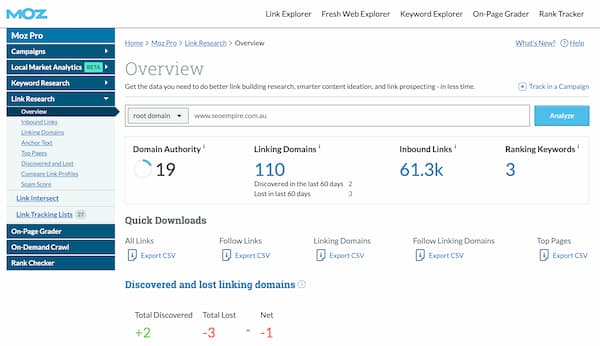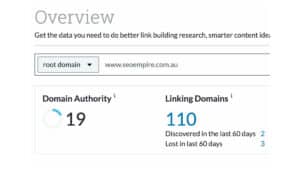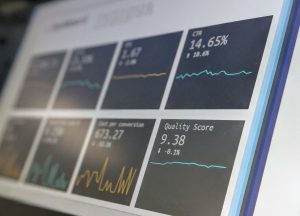How to Increase Your Website Authority (Domain Rating)
Do you want to know how to increase your website authority? If you want to rank higher at Google and have more organic traffic to your website, you might have read that the answer is to increase your website authority. The fact is, however, that while that authority on the platform is never a bad thing, that the score itself should not be the primary focus. Website Authority (or Domain Authority) is described by the SEO tool providers as a metric. This tests the relative strength of the backlink profile of a site as compared to every other place in its index.
Moz developed the Domain Authority metric, but other companies have produced similar parameters that rate domains based on a variety of factors and assign them a ranking from 0 to 100. The concept of rating domains based on their authority originated from PageRank, which was created by Larry Page (one of Google’s founders), which is used as a way of assessing the value of web pages which websites until today.

Nearly every excellent SEO tool has this metric, but it varies in-name and the way it is measured. As for most other indicators of website authority, it typically runs on a scale from 0–100. Having a low Domain Authority is typical for a domain but rank high in Google. There are just a few other things about DA you should know about:
- DA takes no account of the fines levied on Google. A domain that is under a penalty from Google automatically loses its rankings but if Moz doesn’t actually know that. So, though the domain is under penalty, the domain authority will still be prominent.
- Google’s ranking algorithm takes hundreds of factors into account (no one knows precisely the number, but some estimates suggest that there are more than 200) whereas the Domain Authority only takes into account 40 factors.
- Changing your DA-score isn’t easy. It is not something that you can do today on your website and see the immediate rise in domain authority.
- A logarithmic scale of DA is centred on. That means raising the DA score from 20 to 30 is easier but going from 70 to 80 is much harder. When you go up on the scale, it gets harder.
- DA sometimes changes because it’s not a metric to be used to measure your SEO success over time, but instead a website metric to be used for domain comparison.
It’s necessary to note that the Domain Rating scale is logarithmic. That means going from DR 69–70 to DR 9–10 is a lot more complicated. The logarithmic scale also indicates that as a DR 10 site, a DR 20 site is more than twice as ‘authoritative’.
You first need to learn how the Domain Rating is measured before you attempt to raise your domain authority. It is determined by combining various variables into a single ranking, including linking root domains and the number of total connections. Instead, this score can be used to compare websites or track a website’s “ranking power” over time. This is typically not a metric that Google uses to assess search results and has little effect on the SERP.
Domain Authority is based on data from the web index for Link Explorer and uses thousands of variables in their estimates. The actual calculation of the domain authority itself uses a machine learning model to find a “best match” algorithm that most closely correlates relation data with rankings across thousands of real search results that we use as benchmarks to which to scale.
Since the Authority is focused on machine learning algorithms, the score of your platform would always fluctuate when more, less, or different data points are included in the calculation — for example, if Facebook were to acquire a billion new links, everybody’s PA and DA will fall relative to Facebook. For this reason, bear in mind that you should always use Domain Authority as a comparative metric for comparison with other sites’ link profiles, as opposed to an absolute measure that scores the effectiveness of your internal SEO efforts.
They have a metric in Ahrefs, which is called referring domains. Domain Rating (DR), is the domain authority metric used. This is the number of websites that connect to a website or blog. You can see this in Site Explorer for any site you examine.

What is SEO Really About
Some people think the higher your Domain Rating is, the higher the amount. But it is not always that easy because in DR calculations sites only take ‘followed’ connections into account. Links with UGC, supported, and nofollow attributes aren’t going to boost DR. Also, additional links from the same page aren’t going to improve the DR of a site because they have referring domains and not backlinks.
Typically speaking, websites with a relatively large number of high-quality external links (such as Wikipedia or Google.com) are at the top of the domain authority scale while small businesses and websites with less inbound links can have a slightly lower DA score. Brand-new websites should always start with one score from a domain authority.
It may seem “poor” to have a domain score of 55, while a domain score of 85 might seem “good” because of their distances from 100, but it is not valid. Getting a rating higher than or less than 100 does not mean a bad or a useful Domain Authority. The truth is that there is no ideal number since a comparative metric is the Domain Authority. A good score for a Domain Authority depends on the direct competition online. This rivalry involves businesses that have the same keywords like your company listed in search results. We have a similar size and scope of business to yours too.
For instance, if you owned a clothing boutique, you wouldn’t be comparing yourself to Target. Target is in its own league, competing with the likes of Walmart and Amazon. Trying to equate your domain score with that of Target sets your apparel boutique for failure. You would instead look at other clothing boutiques or small-scale thrift shops around the same size as your store. You ‘re going to want to look at all that rank for related keywords also. When you find the same ten websites attempting to rank with your chosen keywords, you should concentrate on these companies and their scores in the domain.
Therefore, a successful score for the domain authority rests on the competition alone. You as your rivals want the highest Domain Authority ranking, but you don’t want it to be so high that you’re out of the race with them. If all of your direct competitors have scores between 40 and 50, a good domain score falls between 55 and 60 for your company. It’s adequate to help you stand above your rivals and have a greater chance of higher ranking in search results.
Since the Domain Authority is intended to be an indicator of the ranking potential of a domain, having a very high DA score should not be the prime objective. Check at the DA scores for the sites you compete with directly in the SERPs, and try to get a higher score than your rivals. This is better used as a comparative metric (rather than an absolute, specific score) when conducting search results research and assessing which sites may have more powerful/essential profiles of links than others. Since it is a connected device, a “good” or “bad” Domain Authority score is not automatically given.
Page Authority (PA) is similar to DA, but it uses signals that are unique to a single page instead of taking domain-wide metrics into consideration. The score given is a forecast that indicates a page ‘s power, and how well it will rank on search engines. A website that has several large authority sites would also have a higher DA score (domain authority). Although Domain Authority measures the predictive ranking strength of entire domains or subdomains, the power of individual pages is calculated by Page Authority.
Anyone can get thousands of links from a bunch of sites that are of poor quality. That is why websites often take into account the link site’s DR score when measuring DR. This means that website backlinks with high DR scores appear to increase the Domain Rating more than those with low DR scores. It is an important idea to be conscious of. It means that as a connection site’s DR rises, so can yours.
For example, if you are building a link from a DR 15 website today, and the owner of that website is working hard overtime to create authority and connections, then the same connection might be from a DR 40 website in one year. And yet even though you’ve only created that one connection ever, your DR score will probably increase over time. The lesson here is that it pays to build links from sites that display promise, even if their DR scores at the time are minimal.
But how do you measure ‘potential?’ ‘Search their content first. If they publish high-quality material, they ‘re more likely to naturally draw high-quality links over time. Second, search in Ahrefs’ Site Explorer for their link development. If the referring domains graph involves a slow and steady upward slope, chances are things will proceed in that direction, and their DR will expand over time.

Let’s say you’re building two ‘followed’ links: The Guardian’s and IMDB’s. All of these sites have the same DR scores, but which connection will most increase your Domain Rating? It depends on how many pages they connect to each, with at least one connection followed. The more unique websites to which a website links, the fewer so-called “DR equity” it the move. So, let’s just test the list of Connected Domains for each site and search only for ‘followed’ links.
The Guardian connects more pages than IMDB (272,218 vs 5,256) to about 50 times more. So IMDB ‘s connection will increase your Domain Rating more than The Guardian’s one. Let’s look at how much a difference this will bring to DR. There’s one referencing domain on this website which is IMDB. The ranking for DR is 34.
There is still one referencing domain on this website, but this time it’s The Guardian. It is 1.5 for DR ranking. It’s important to remember that this doesn’t make all IMDB links more ‘authoritative’ than The Guardian links. Several variables make for a reliable backlink.
Now the problem of rising your Domain Ranking comes up. Create more ‘followed’ links to your website, and through your Domain Rank. Everything is only as plain as this. Also bear in mind that if the site from which you get a connection has a low DR score or links to other websites, the improvement in Domain Rating may be marginal.
It’s also important to remember that creating links to random pages does not always help your rankings or organic traffic to increase. You will concentrate on creating relationships directly to the pages you want to rank in Google because that is almost definitely your end goal. It would have a more significant effect on organic traffic and rankings than merely “that DR.” The number of domains linking to a page correlates more strongly with organic traffic than the ranking website’s DR.
That said, it’s not always easy to create links to the page you wish to rank in Google. For example, having people to connect to a page selling business cards will be hard for a printing company, as there is little motivation to do so. Here’s how to indirectly increase the authority of your website (domain) through more effective means.
The most critical metric of all is your relation profile. Websites with a solid, clean profile will have a higher DA score than sites with a not that good profile of links. A website has an excellent profile of connections, when:
- This has entrant connections from places of high authority
- Entry links are from linked websites
- It has no bad ties (low-quality connections)
- It has contacts from several distinct domains
The process of improving your link profile is known as Off-Page SEO and is linked to the techniques that you can use to obtain useful links that will eventually increase your ranking. To boost your relation profile, and enhance your Domain Authority among other items, you need to do the following:
Get rid of those bad ties. This method includes using a device such as Moz Explorer or Semrush to find out which relationships are toxic. You may then contact the owners of the website and ask them either to delete the link or to add the “nofollow sign” to devalue it. If this doesn’t work, you can delete the links from your profile using the Google disavow feature. You may be given some not-so-great links to your page when you seek to gain reliable links to your website. Websites that connect to your profile will damage your score on the Domain Authority.
To check the types of links you are getting, you need to browse through your profile. Most domain checkers provide checker tools with the backlink. Just like Ahrefs, you can use backlink checker tools to see which sites link to your content. This gives you the ability to pick poor backlinks, get in contact with those websites and ask them to delete the link to your site.
That method also refers to links that appear on your website. You need to browse through your website and search your pages for links. Delete any bad links and patch any broken ones that might damage your score on your domain. You’ll help increase your domain ranking by eliminating weak and broken ties. You will get closer to a good rating from the Domain Authority because you will only have reputable and authoritative sites that connect to your website.
Gain strong links from websites linked to it. It is the tricky part, and one of SEO’s most demanding pieces. Link building is a big subject of its own, and it’s something that beginners find hard to understand and implement from practice.
Have excellent web content that will draw connections from other websites. This is known as ‘normal connection building,’ and the idea is that someone finds your website, reads your posts, likes it, and connects from one of their posts with it. You need to have link-worthy content published on your website for this to work. In other words, material that is informative, useful, and easy to read, so that other webmasters are able in their posts to reference it. In practice, this method works, and it’s beneficial, but you need to be cautious because it will take time to gain enough readership to share your content in their blogs with some of the readers.
The second way to get reliable connections is by reaching out to other webmasters and letting them know you already exist. In doing so, inside their posts, you increase the chances of linking to the web site.
The next step to boost your domain authority is to focus on the SEO on your blog. On-Page SEO has to do with the website and content optimisation. The most striking considerations are:
- Titles and Definitions finely configured
- Use of the headings (H1 and H2) properly inside your material
- Structure of URLs and structured Permalinks for SEO.
- SEO Optimise your photos, videos and other elements of your media
- Use of keywords in your text, naturally (no keyword stuffing)
- Adding internal links (this is a very effective SEO technique) to your content
- Formatting the content is such a way to give Google’s featured snippets more chances of rating.
It is important to note again that for both on-page and off-page SEO, the content quality is the most significant ranking factor of all. As mentioned in one of Google’s SEO Guides, keeping your content fresh and up-to-date is vital.
Technical SEO is linked to low-level SEO tasks, and typically you do not have to deal with it again once you get your technical SEO right from the start. At the other hand, if your website’s technological SEO element is not right, it can have an immense effect on your domain authority and rankings. The leading SEO settings you need to test for include:
- Using Google Search Console and Bing Webmaster to sign the website
- Build and customise your sitemap with XML and upload it to Google
- Check the settings for robots.txt and use Fetch as Google to make sure Google and other spiders on the search engine can crawl the website without any problems.
- Try getting the website migrated to https.
- To help search engines understand the meaning of your content, add structured data schema) details.
- Make sure that every page has an adequately specified breadcrumb menu.
- Using hreflang properly (in case you have a multilingual website)
It’s no longer optional or cool to have a mobile-friendly website, but it’s mandatory. Here are some reasons:
- There are now more than desktop web searches (around 60 per cent).
- Most users start their mobile search and then continue their search on Desktop
- User-friendliness is a rating factor (for user results seen on Google)
- Google operates on a first mobile index and websites that are not internet friendly obviously won’t be included
- Not having a mobile-friendly version of your website (or responsive website), affects your overall Domain Authority Score negatively.
If your website is not yet mobile-friendly, the easiest way to get started is to go to Google’s Mobile-Friendly App and run the Domain check. Google will send you an excellent report with tips on making your website ready for mobile use. You can also consider adding support for AMP (Accelerated Mobile Pages) to your site.
One of the established Google ranking algorithm ‘signals’ is page velocity. Websites which load more quickly have an additional advantage over slower sites. Improving your page speed will not only increase your rankings and domain authority, but it will also boost your user experience, which means more purchases, leads and signups. Tackling the question of page speed isn’t always convenient. There are plenty of technical aspects involved, and it can be very complicated if you’re not a developer or anyone with specialised experience. Nonetheless, if you can not afford to employ a developer to improve your website’s loading pace, you can test the following:
- Set aside obsolete plugins
- Upgrade to the new versions of WordPress (and plugins).
- Call your hosting company and request that they send you a report on the performance of your server. Upgrade to a more powerful server where necessary.
- Using a plugin (such as w3 total cache) for caching
- Optimise the size of photos in files
- Of videos using a streaming service (such as YouTube)
- In case you have big CSS files and many images, use a CDN (Content Delivery Network)
While Google has officially confirmed several times that social signals are not part of the Google Ranking algorithm, pages that rank high on Google and social signals are clearly highlighted. Pages famous on Google seem to have lots of likes, shares, and tweets. To improve your domain authority, all you need to do is:
- Working on your Facebook company page and trying to boost your followers
- And ensure that you have an active social media presence in each of the social networks and get some exposure to the content you post (likes, tweets, +1s, etc.).
- To ensure that you have a social media button on your pages to make the sharing of your content simple for readers.
- Use the social media buttons to test that your content looks good.
As mentioned in this post ‘s introduction, your domain authority isn’t something that can be achieved overnight. After you make all of the above adjustments, it will take time for people to read and analyze your website, so you need to be careful. Working consistently to boost your google rankings would also have a good effect on the score for your domain authority.
Domain Authority can be hard to directly impact. It consists of an aggregate of metrics and related data which affect the score of the authority. It was done intentionally; its parameter is intended to measure how competitive the search results for a particular site are in Google. Since Google takes into account several factors, a metric that attempts to regulate it often has to incorporate a lot of factors.
Improving the overall SEO is the best way to impact Domain Authority metrics. In particular, by having more links from other well-linked sites, you will be concentrating on your link profile. Since the domain authority (and, for that matter, the Page Authority) is made up of various metrics and measurements, it can be a challenge to determine the exact cause of a transition. There are several possible driving factors, including things like whether your score has gone up or down,
- The growth in your link profile has not been captured in our web index yet.
- The highest-authority sites witnessed substantial growth in linkages, skewing the mechanism of scaling.
- You’ve won connections from sites that don’t rank in Google.
- We crewed (and included in our index) more or fewer of your connecting domains than we had before.
- Your domain authority is at the lower end of the scoring scale and is thus more influenced by the fluctuation of the scaling.
The secret to understanding variations in the Page and Domain Authority is that such measures do not exist in a vacuum — they rely on both positive and negative variables, so that even though a given site enhances its SEO, it may not always represent its Authority score(s). As they are calculated on a 100-point method, the recalculations after each update mean that the Authority score of a given page/site will go down even though that page/site has improved the quantity and quality of its connection. This is the essence of a scaled, relative structure. As such — and this is critical enough to stress it once again — the Authority scores are better used as comparative rather than absolute metrics.
Ultimately, do not be too concerned with your domain authority ranking. It’s just a number that indicates how big your domain is in comparison with other domains in the Moz database. A low DA score doesn’t mean your website is not going to perform well on Google. A high DA score means you ‘re on the right track, but it doesn’t guarantee you ‘re going to get better rankings or traffic, it’s just a guess. Seek also to think of the big picture, which is to create a website that will achieve stable rankings in Google and other search engines over time.
Improving the reputation of your website should never be your principal target. Instead, concentrate on creating high-quality links to the pages you wish to rank from relevant and authoritative sites. As a normal byproduct of this cycle, your Domain Rating will grow.




